Muscle Mechanical Model and the Mézières Method
Dr. Massimo Benfatti
Muscular Mechanical Model and Mézières Method
Massimo Benfatti, Physiotherapy Graduate
Anatomical notes
Our muscles are composed of muscle bundles covered by a dense network of connective tissue called perimysium. Muscle bundles can be subdivided into many smaller thinner filaments called muscle fibers. These fibers are in turn covered by another connective tissue called endomysium, with the size of these fibers ranging from 10 to 100µ.
Each muscle fiber is further subdivided into many small myofibrils about 1 or 2 µ in size, also covered by a connective tissue membrane called sarcolemma.
Myofibrils are composed of contiguous or joined filaments, depending on the action exerted (contraction or relaxation), of actin and myosin.
In the muscle, therefore, two different elastic materials are found: the contractile part of actin and myosin and the connective part of membranes and tendons.
Given these premises, we develop a muscular mechanical model in which these two variables will be inserted.
As for the contractile part of the muscle, it can only contract and relax having an elasticity coefficient of about 1, that is, no permanent structural modifications will remain in it, but a temporary modification due to the contractile stimulus may persist.
The connective components, on the other hand, depending on their elasticity coefficient, may remain shortened or lengthened proportionally to the force, duration and frequency of the stimulus applied to them.
Schematically, the elastic connective elements of the muscle are divided into two:
• Elastic elements in series (Es);
• Elastic elements in parallel (Ep).
Elastic elements in series (Es)
These elements consist of tendons and their extensions inside the muscle belly.
Their action is to "absorb" during muscle contraction the stresses produced both when a muscle shortens and when it stretches.
Moreover, the presence of protective structures such as the Golgi tendon organs prevents damage to the Es, inducing muscle relaxation when the tension becomes excessive and thus preventing complete stretching.
An additional advantage offered by these structures is to return the accumulated energy, like a spring, based on their elasticity.
Elastic elements in parallel (Ep)
These elements consist of the sarcolemma (connective membrane covering the myofibrils), other connective membranes and interposed connective tissue.
Their action is to "dampen" the stresses produced by stretching by reducing resistances.
These elements, together with the neuromuscular spindles and Golgi tendon organs already mentioned, perform an external and internal protective action on the muscle itself.
In fact, in a traction or contraction, where the contractile part participates in the first person, the Es and Ep contribute significantly to the process.
Considerations on internal and external mechanical stimuli applied to the muscle
Legend:
C= contractile part of the muscle;
Es= Elastic in series;
Ep= Elastic in parallel;
L= Muscle length from origin to insertion;
Les= Length of Es;
Lep=Length of Ep;
Lc= Length of C.
= Active forces
= Movement
Normal conditions of muscle rest optimal length state.
fig1

Isotonic concentric muscle contraction
The muscle contracting pulls the Es which behave elastically cushioning the stresses and distributing the displacement to the joint heads, which do not deform.
The Ep instead, being arranged in parallel, shorten, this shortening will be more effective and lasting the greater the contraction force and the time it will be maintained.
Such shortenings will be permanent based on the considerations previously made on the elasticity coefficient.
Hence we will have:
L1 < L;
Les1 ? Les;
Lep1 < Lep;
Lc1 < Lc.
After a contraction of this type, repeated countless times over the course of life and associated with postural imbalances in which the muscle always works in
shortening (to maintain equilibrium not conforming to the engineering reference biotype), we would have the following condition:
fig2

Muscle relaxation after an isotonic concentric contraction
The contractile part in non-pathological conditions returns to its starting length, also being the overall length of the muscle shorter, since it is constrained by the length of the Ep, the Es will also be compressed by the released contractile part C and therefore, having to occupy the same space, will have to shorten permanently.
Hence we will have:
L2 < L;
Les2 < Les;
Lep2 < Lep;
Lc2 = Lc
Having to perform a high number of isotonic concentric contractions the musculature will always tend to shorten; the model therefore explains why muscle shortenings will influence posture, it is obvious that such modifications will only be possible based on the forces and contraction time repeated over the course of life.
Furthermore, as we will see later with precise techniques this process will be reversible.
This also explains the fact that to respond to another mechanical law of muscular energy saving the contractile part is functionally and anatomically replaced by the connective one.
fig3
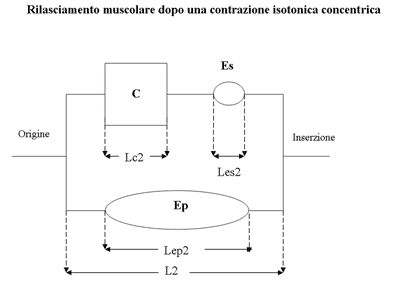
Passive stretching of a shortened muscle
In the passive stretching of a muscle all elements will be lengthened, but constrained by the limit of possible joint excursion.
However, the more elastic elements will tend to lengthen more easily while those already shortened and less elastic will resist lengthening.
That said, we can therefore observe that the contractile part of the muscle will lengthen easily, with a little more difficulty the part of the parallel elements will do so, being directly dependent on the distance between origin and insertion, and therefore on the applied forces.
The elastic elements in series, on the other hand, will undergo only a small almost negligible elongation, this because the contractile part will compensate for the elongation imposed on the muscle (this modulation of tension between C and Es will be carried out by neuromuscular spindles and the Golgi tendon apparatus).
At this stage we will have:
L3 > L;
Les3 < Les;
Lep3 > Lep;
Lc3 > Lc
fig4
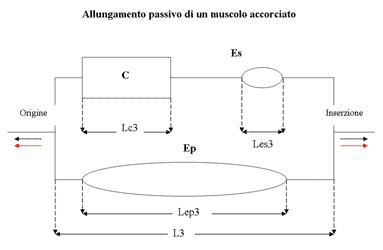
Muscle relaxation after passive stretching
Once the external force is removed the changes made will never be enough to return the muscle to the original optimal length condition.
This is because, after stretching, the contractile part will return to non-pathological conditions at the initial length pulling the Es (which will have undergone a negligible elongation from the applied tension) and consequently shorten the Ep.
Hence we will have:
L4 < L;
Les4 < Les;
Lep4 < Lep;
Lc4 = Lc
All this makes us understand that after the establishment of an inevitable muscle shortening, a passive stretch, even if perfectly performed, cannot bring the musculature back to the optimal length state.
A very effective way to achieve the optimal state of muscle length, as already explained by Mézières herself, is to use an isometric contraction after placing the muscle in maximum relative or absolute length.
Let's see why:
fig5
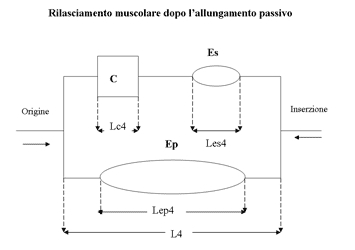
Isometric contraction after maximum absolute or relative muscle lengthening
After placing the origin and insertion as far apart as possible, the contractile part is asked to shorten, such action cannot do otherwise, being the joint heads fixed, to stretch the Es by traction.
Hence we will have:
L5 > L;
Les5 > Les;
Lep5 > Lep;
Lc5 < Lc
fig6
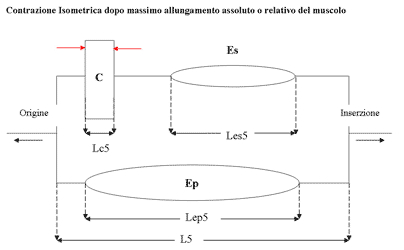
Relaxation of muscle contraction and stretching tension after an isometric contraction at maximum possible stretch
After such work the same original length conditions will be present; a possible reduction in the length of the contractile part will be countered with myorelaxing techniques (massage, thermotherapy, rhythmic movements etc.)
The greater the tension and duration, the greater and longer-lasting the length changes of the muscle.
Hence we will have:
L6 = L;
Les6 = Les;
Lep6 = Lep;
Lc5 = Lc
fig7
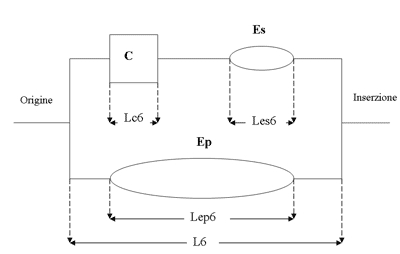
Conclusions
From what we have explained, it is clear that the muscle length stock will progressively tend to decrease and the human structure will have no choice but to organize posture in such a way as to always respect three fundamental laws: comfort (no pain), balance (whatever the way), energy saving (use of connective tissue).
One possible means of reprogramming posture is precisely to selectively bring back to the optimal length those muscles that are more shortened than others and this can only be done using isometric contraction at maximum absolute or relative muscle lengthening.
Bibliography
Arthur C. Guyton.: “Neurosciences – Basics of Neuroanatomy and Neurophysiology”. Piccin, 2nd edition.
Busquet L.: “Muscle Chains – Trunk, Cervical Spine and Upper Limb – Volume I”. Marrapese publisher, 2nd edition of the French 5th, Rome, 2002.
Pirola V.: “Kinesiology - Human movement applied to rehabilitation and sports activities”. Edi Ermes, Milan, 2002.
Mézières F.: “Originality of the Mézières method”. Translation by Mauro Lastrico, specialist Metodo Mézières, “Centre Mézières”, Paris.
Notes of the theoretical-practical course of R.M. Mézières year 2006 teachers, Mauro Lastrico and Laura Manni.
Contact with the author:
Cell: 3496603253
e-mail: ft.massimobenfatti (AT) alice.it
Copyright © 2025 AIFiMM Formazione Mézières Provider E.C.M. n. 1701. All rights reserved.



